Mining enterprises, by their very nature, were often located in isolated mountainous areas with low population densities significantly distant from commercial centres. Mining entrepreneurs, therefore, had unique problems to contend with in organizing their enterprises. Their common problem was a lack of infrastructure—no streets, no churches, no schools, no residences, no utilities, and no banks or financial intermediaries. The specialised industries that might otherwise have provided these services were dissuaded from doing so by the high start-up costs and the enduring uncertainties of dealing with low-income communities that might be there today and gone tomorrow. Mining companies, therefore, built residences, churches, schools, and water works, and opened company stores or commissaries. In so doing, they became both buyers of labour from, and sellers of commodities to, the miners and their households. This kind of organization, coupled with the difficuly and danger associated with transporting currency to the mining areas (think Butch Cassidy and the Sundance Kid) invited the use of alternatives, suck as tokens or scrip, in lieu of ordinary money.

Calmalli is located just north of the border between Baja California and Baja California del Sur. The Calmallí mine was an old gold mine that was reestablished in 1884{footnote}La Patria, Año VIII, Núm. 2082, 11 April 1884{/footnote} and worked by the Ibarra brothers (Ybarra Gold Mining Company), with Emiliano Ibarra as president.


Grove 1940
Obverse: TIENDA DE RAYA / Y / CALMALLI
Reverse: ¼
17mm. brass
Grove 1941
Obverse: TIENDA DE RAYA / Y / CALMALLI
Reverse: ½
21mm. brass
Obverse: TIENDA DE RAYA / Y / CALMALLI
Reverse: 1 / REAL
Grove 1942
Obverse: TIENDA DE RAYA / Y / CALMALLI
Reverse: 2 / REALES
29mm. brass


Grove 1943
Obverse: TIENDA DE RAYA / Y / CALMALLI
Reverse: 4 / REALES
32mm. brass
Grove 1944
Obverse: TIENDA DE RAYA / Y / CALMALLI
Reverse: 1 / PESO
38mm. brass
All these were made by C. A. Klinkner & Co. of San Francisco.
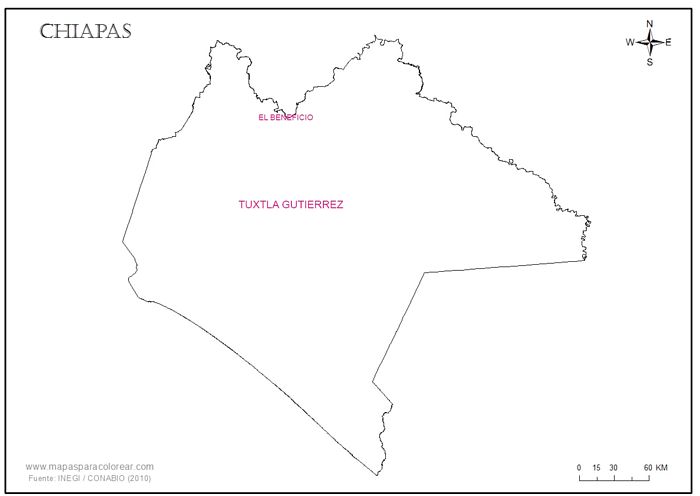
The Chiapas Mining Company was registered in London on 26 April 1889 with a capital of £250,000. It operated the La Providencia and Santa Fe mines, situated in El Beneficio, a community located in the foothills of the northern highlands of Chiapas, from 1889 to 1905.
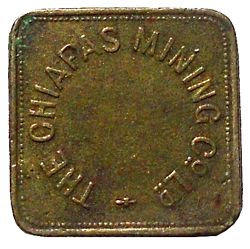
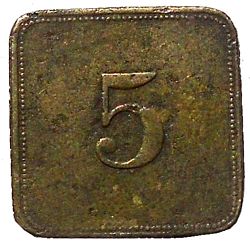
Obverse: THE CHIAPAS MINING CO LD
Reverse: 5
brass
Grove 1731
Obverse: THE CHIAPAS MINING CO LD
Reverse: 50
28mm.
 Santa Clara
Santa Clara

Grove 1898
Obverse: FRANCISCO T. HERNANDEZ / 50 / SANTA CLARA
Reverse: ES BUENA POR UNA / 2 / RACION DE MAIZ
25mm. bronze
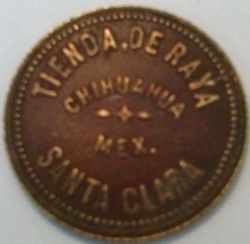
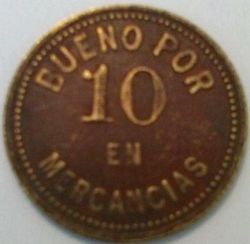
Obverse: TIENDA DE RAYA / CHIHUAHUA / MEX. / SANTA CLARA
Reverse: BUENO POR / 10 / EN / MERCANCIAS
24mm. brass
Obverse: TIENDA DE RAYA / CHIHUAHUA / MEX. / SANTA CLARA
Reverse: BUENO POR / 20 / EN / MERCANCIAS
28mm. brass
In 1883 Matras Alsua and some relatives, and B. Phelps of New York, took over the gold-silver mines of Santa Juliana near the source of the river Mayo. These mines had been worked in colonial times but had been abandoned about 1810. They were pumped dry by some others and the Alsuas in the 1870s.
The Santa Juliana Mining Company is listed in New York City Directories in 1894 and 1896. The 1897 Mine, Quarry And Metallurgical Record Of The United States, Canada And Mexico notes that the Santa Juliana Mine has 1,250 feet of shaft and tunnel, with product being Gold & Silver, 12,000 tons, 300 days, and 400 employees. Its stamp mill had a 40 ton daily capacity, powered by electricity, steam, and water.
On these tokens the reverse pictures indicated the denomination to basically illiterate workers. It is assumed that the diameter is an indication of increasing value.

Grove 1746
Obverse: SANTA JULIANA MINING CO. / JESUS MARIA / 1893
Reverse: an ore car
16 mm. nickel
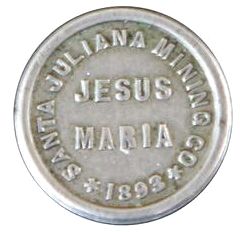
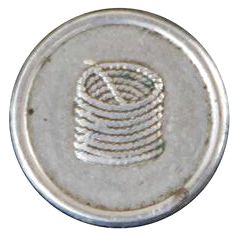
Grove 174
Obverse: SANTA JULIANA MINING CO. / JESUS MARIA / 1893
Reverse: a coil of rope
mm. nickel
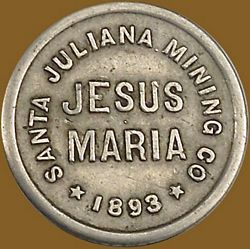
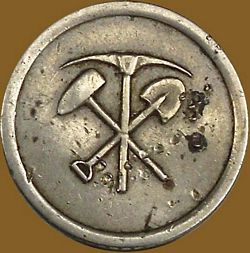
Grove 1747
Obverse: SANTA JULIANA MINING CO. / JESUS MARIA / 1893
Reverse: a pick, shovel and sledge hammer
19 mm. nickel
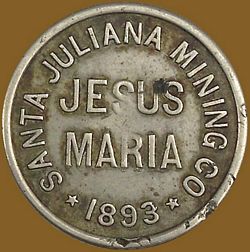
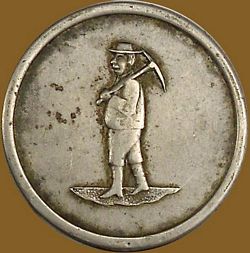
Grove 1748
Obverse: SANTA JULIANA MINING CO. / JESUS MARIA / 1893
Reverse: a miner with a pick
22 mm. nickel
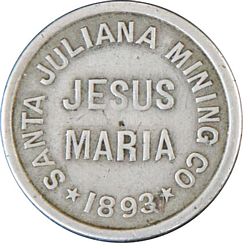
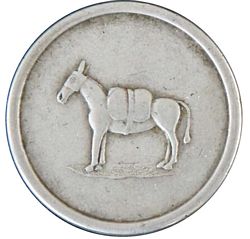
Grove 1749
Obverse: SANTA JULIANA MINING CO. / JESUS MARIA / 1893
Reverse: a pack mule
25 mm. nickel
In 1894 a Mexico City newspaper reported that before the law prohibiting payments in scrip (fichas, cacharpas, vales al portador y otros objetos) came into effect, the practice was rife but now people were paid in legal tender. However, in Ocampo it appeared that the law was less efective, given the great circulation of aluminium tokens (monedas ó contraseñas de aluminio) issued by the Compañía Minera de Santa Juliana, redeemable only in the tienda de raya for highly-priced goods. Any worker who needed banknotes to pay his taxes etc. had to sell the tokens at a 25% discount to other businesses as the tienda did not exchange them at any price{footnote}Voz de México, Mexico, 4 August 1894{/footnote}.
Grove 1935
Obverse: JESUS MARIA / STELL
Reverse: BUENO POR / 1 / COPA
19mm. brass.
Guillermo (William) M Stell, a doctor and surgeon{footnote}Periódico Oficial, Chihuahua, 21 January 1909{/footnote} became interested, along with Luis Siqueiros, in the Matelura mine in Jesús María in 1891{footnote}Jesus Maria, Chihuahua.
Dr. W. M. Stell. Of Jesus Maria, is in the city, attracted by the convention. He is interested in the Matelura. This property is being worked actively and the product is being milled at the John Watterson plant.
The product of the Matelura amounts monthly to about $4,000, but steps are being taken to increase the output of the property materially. Don Luis Siqueiros is associated with Mr. Stell in this promising property.
The Santa Juliana mine and mill are in an active state and are shipping bullion monthly to Chihuahua. (The Two Republics, vol 33, No. 148, 19 December 1891){/footnote}. By June 1892 Stell and Siqueiros were working the mine and contemplating establishing their own plant{footnote}Daily Anglo-American, 20 June 1892{/footnote}, for which they drew water from the nearby river. By 1910 Stell owned the Lupe de Oro gold and silver mine{footnote}Diario Oficial, 26 April 1910{/footnote}.
Gaytan{footnote}Carlos, Gaytan, Paper Currency of Mexico{/footnote} provides a history of the Rascon brothers of Uruachic, Chihuahua. In his article he writes that the Rascon family, José Maria and Leogardo, arrived in the area in 1750. "Leogardo was first to strike a Bonanza when he discovered a gold mine he named “La Bola”. Probing about for more, the brothers made another important strike, “El Omelichi,” just two miles west of “La Bola."
The brothers died in 1818 and 1820 and the mines were flooded after heavy rainfall and ceased production. The remaining family turned to farming and it was not till 1858 when two other Rascon brothers, Epigmenio and Ignacio Rascon, only sons of Leogardo, pumped out the water from “La Bola” mine and restarted operations. The company bought other mines in the area such as Las Animas, San José, Santa Rosa, El Alacran, San Lazaro and many more, and built a very modern hacienda de beneficio with batteries brought from England to crush the ore. In time Rascon brothers were running one of the most successful operations in the state. An indication of their wealth was that their house had the first porcelain toilets and baths, sent all the way from London.
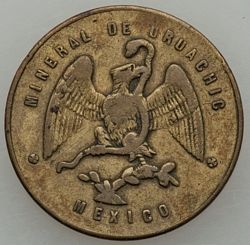
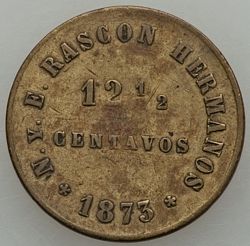
Grove 1751
Obverse: around Mexican eagle MINERAL DE URUACHIC / MEXICO
Reverse: N. y E. RASCON HERMANOS / 12½ / CENTAVOS / 1873
25mm. brass

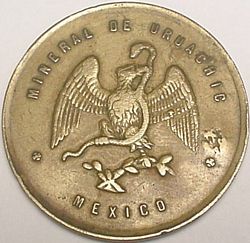
Grove 1752
Obverse: around Mexican eagle MINERAL DE URUACHIC / MEXICO
Reverse: N. y E. RASCON HERMANOS / 25 / CENTAVOS / 1873
28mm. brass
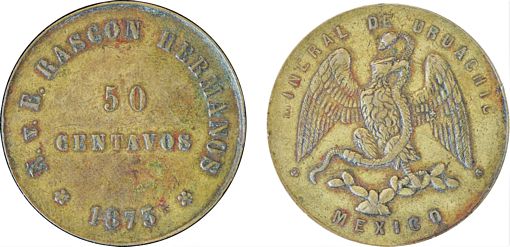
Grove 1753
Obverse: around Mexican eagle MINERAL DE URUACHIC / MEXICO
Reverse: N. y E. RASCON HERMANOS / 50 / CENTAVOS / 1873
31mm. brass
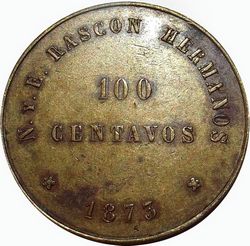
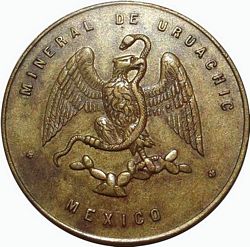
Grove 1754
Obverse: around Mexican eagle MINERAL DE URUACHIC / MEXICO
Reverse: N. y E. RASCON HERMANOS / 100 / CENTAVOS / 1873
mm. brass
In 1873 bronze tokens of 12½, 25, 50 and 100 centavos, produced at the Alamos Mint, were issued by Minera de Uruachic. In addition, paper notes were put into distribution produced locally or printed by The American Bank Note Company in New York. Both were redeemable at the company store, which was run by their relatives, Ezequiel and Daniel Rascon.
The tokens were marked on the back by the letters N and E RASCON HERMANOS. One of the more interesting aspects to the tokens is what has been called a five leaf counter stamp or countermark stamping out the “N” on the 12½ centavos and other values. The tokens have been sold with that description in several auctions.
However, the late Ken Tabachnick, a prolific coin collector and dealer, told me the story that a falling out between the brothers resulted in the stamping out of the letter “N”.
 12½ centavos with "N" stamped out
12½ centavos with "N" stamped out
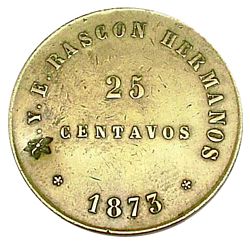 25 centavos with "N" stamped out
25 centavos with "N" stamped out
Was this a dealer story to sell the coin? In inspecting my 50 and 100 centavos coin I find the “E” stamped out.
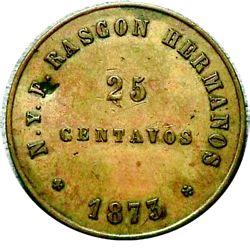 25 centavos with "E" stampted out
25 centavos with "E" stampted out
Was this the other brother retaliating and punching out his brother? On the other hand, the stamped out letter may have been used to denote that a token had been spent, or was perhaps out of date.
Gaytan goes on to say: “In its hey-day, Uruachic had a population of nearly 15,000; today there are less than 400 living there. The Municipality of Uruachic is bounded on the north by Ocampo, on the south by Chinipas and Guazapares and on the west by the State of Sonora”.
(from Elmer Powell, The Rascon Brothers and the Compañía Minera)


Grove 1725
Obverse: MENDOZA & NESBITT / BARRANCA / DEL COBRE / CHIH, MEX.
Reverse: VALE POR / 25 / CARNE
33 mm. brass
Grove 1726
Obverse: MENDOZA & NESBITT / URIQUE / CHIH, MEX.
Reverse: VALE POR / 25 / CARNE
33 mm. brass


Grove 1156
Obverse: BATOPILAS / ESTADO / DE / CHIHUAHUA / 1887
Reverse: VALE POR / UN / REAL
23 mm. brown vulcanite
For a history of the mining town of Batopilas and possible issuers of this token, see this companion piece on paper currency.
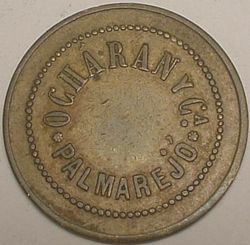
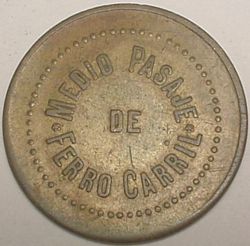
Grove
Obverse: OCHARAN Y CA / PALMAREJO
Reverse: MEDIO PASAJE / DE / FERO CARRIL
23 mm. brass
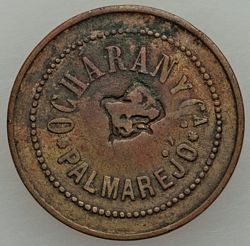

Grove 1799
Obverse: OCHARAN Y CA / PALMAREJO counterstamped with a bull's head
Reverse: MEDIO PASAJE / DE / FERO CARRIL
23 mm. brass
Grove 1800
Obverse: OCHARAN Y CA / PALMAREJO counterstamped with the letter J
Reverse: MEDIO PASAJE / DE / FERO CARRIL
23 mm. brass
Mineral deposits were discovered at the site of the Palmarejo mine in 1818 by Valentine Ruiz, who immediately took on a partner Tomas Pelayo, and registered the mine as Nuestra Señor Cármen. Tomas Pelayo passed away in 1823 and that same year Rafael Ayon bought into the firm for $8,000, but in 1827 sold part of his holdings to Vicente Palacios of Chihuahua and Antonio Lamadrid of Alamos, Sonora. Finding themselves low in funds, the partners obtained a loan in 1837 from Miguel Urrea of Alamos. By 1841 Palacios and Lamadrid had died. Ayón, unable to continue working the mine, sold his interest to Miguel Urrea, who also was successful in purchasing the other partners' interests from heirs to their estates.
By 1853, after an investment of $1,000,000 pesos the Palmarejo (by then a walled compound to ward off the Apache raids) the Justina and the San Miguel mines (the latter two miles from Chinipas near El Zapote) were operating, together with some 35 small crushing milIs. After Miguel Urrea' death in 1875 the mines continued to flourish under the ownership of the widow, Justina Almada de Urrea and her brother and brother-in-law. A bonanza existed from 1878-1880. During that time it is claimed that the mines yielded ore to the wealth of one million pesos.
A British mining engineer, Edward Applegarth, after examining the mining funds (claims, workings, reserves, reduction plants and all facilities and properties) at El Zapote and Palmarejo, returned to England to report. As a result, the Palmarejo Mining Co, Ltd. was formed in London and the Urrea properties were purchased by them in 1886 for $800,000 pesos. Plans were immediately initiated by the new owners for a narrow gauge railroad from Palmarejo to El Zapote for the purpose of transporting ore and supplies.
On 25 June 1898 a new firm, Palmarejo & Mexican Gold Fields Ltd. was incorporated in London as a reorganization of the Palmarejo Mining Co. Ltd. The reorganization also included the purchase of the property of Goldfields of Mexico Ltd at a cost of $548,800 pesos. The newly organized company concentrated on building a stone aqueduct 14 miles long from the Chinipas River to Palmarejo and cornpleting the railroad from El Zapote to Palmarejo. A year or two later the Mexican Mineral Railway Co. Ltd. did complete the railroad. Rather than assume the unfamiliar task of operating a railroad themselves, the Palmarejo & Mexican Gold Fields Co. leased it to Oscar Ocharan, a resident of Alamos. The Company had big plans for the mine and poured over $5,000,600 into development before the first dividend was issued to stockholders.
Unfortunately the improvements and even the little toy railroad soon outlived their usefuJness. In 1910 plans were made to tear down the mill at El Zapote and erect a new 300-stamp mill and build an aerial tramway from Palmarejo to the mill to replace the railroad. By the end of 1911 a hydroelectric plant was completed and the new mill and aerial tramway were en route to the mill to be assembled but the revolution caused everything to be suspended. Oscar Ocharan was exiled in 1912 to the United States. During the period of the revolution, the railroad, the mine and much of the company's property was lost, not because of any military action but because of abandonment and deterioration. As a result, the company entered a claim with the Anglo-Mexican Special Claims Commission for $2,600,000 and in August 1931 a decision was made to award the company for Ioss and damages the sum of $412,000 gold pesos to be paid in eleven annual installments. In 1933 The company finally went into production again. The mine is still being worked.
During the time when the railroad was in operation, little brass tokens were issued, bearing on the reverse side, the words MEDIO PASAJE DE FERRO CARRIL. There are several interpretations of this wording and possible use but the most likely is that the MEDIO PASAJE refers not to half-fare, but rather to half passage. A full trip would be to the mine and back. A medio pasaje would be one way between the two terminals. Tokens such as these are usually used for human passengers and yet it is difficult to see the need for such tokens on an isolated mining railroad. There remains the possibility that they may have been used to pay the transport of a load of ore or freight one way between mine and mill.
This token is also found with the steer head counterstamp of the Quintera Mining Company. A hoard of Palmarejo tokens may have been procured by the Quintera Company, counter stamped and put to use on Quintera ranches.
(based on Elwin C. Leslie, The Palmarejo Railroad Token)
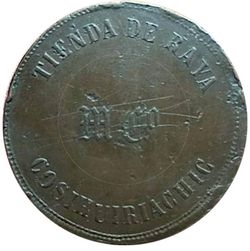
Grove 1946
Obverse: TIENDA DE RAYA / M. Co / COSIHUIRIACHIC
Reverse: 1880 / ¼ / DE REAL EN EFECTOS
23mm. bronze
Grove 1947
Obverse: TIENDA DE RAYA / M. Co / COSIHUIRIACHIC
Reverse: 1880 / ½ / DE REAL EN EFECTOS
30mm. bronze


Grove 1948
Obverse: TIENDA DE RAYA / M. Co / COSIHUIRIACHIC
Reverse: 1880 / 1 / REAL EN EFECTOS
35mm. bronze
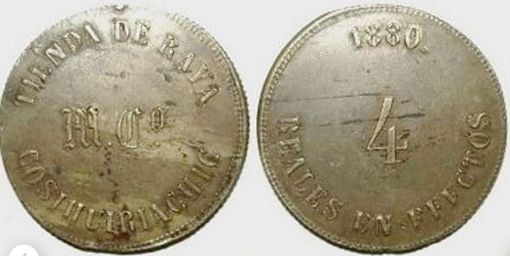
Obverse: TIENDA DE RAYA / M. Co / COSIHUIRIACHIC
Reverse: 1880 / 4 / REALES EN EFECTOS
These were issued by the Santa Rosa Cosihuiriachic Mining Co.
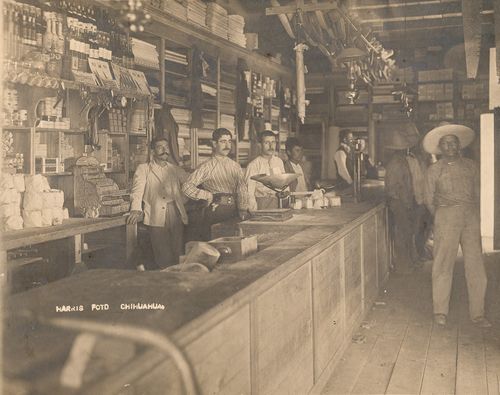
Naica is a mining community about 22 miles south of Delicias in south-east Chihuahua. In 1910 it had two thousand inhabitants, mostly employees of the Compañías Explotadora de Naica, Compañia Minera de Lepanto, Compañia Minera de Naica and the Mighty Mountain Mining Company.
The Italian Jose de Stephano listed himself as a miner and merchant in the 1910 Album del Centenario. As a miner, he was president of the Compañía Minera de Lepanto (and Chihuahua representative for the Compañía Minera Fundidora y Afinadora de Monterey){footnote}The Mexican Herald, 22 January 1908{/footnote} and as a merchant, owner of the wholesale and retail store "Tienda Lepanto", which employed six staff{footnote}Anuario Estadístico del Estado de Chihuahua, 1909{/footnote}, no doubt the same as the "Tienda La bella Napoli".
This 10c token is for another of his stores, "La Gran Ciudad de Roma".

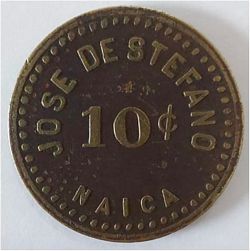
Obverse: VALE SOLO EN - LA GRAN / CIUDAD / DE ROMA.
Reverse: JOSE DE STEFANO / 10¢ / NAICA
24mm. bronze


Grove 1453
Obverse: VALE SOLO EN - LA GRAN / CIUDAD / DE ROMA.
Reverse: JOSE DE STEFANO / 20¢ / NAICA
27mm. nickel
Stefano also seems to have issued paper notes. In 1909 the Secretaría de Hacienda fined de Stefano five hundred pesos for using various ‘papeles ó tarjetas’ with a fixed value in his store{footnote}El Diario, 29 July 1909{/footnote}. Another newspaper described his system as ‘unos formularios, tarjetas ó libretas’{footnote}El Diario del Hogar, 28 July 1909{/footnote}.

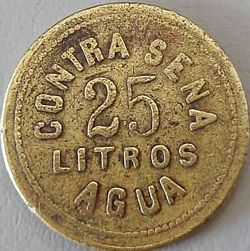
Obverse: MIGUEL OCADIZ / 25 / SIERRA DE NAICA
Reverse: CONTRASENA / 25 / LITROS / AGUA
Obverse: MIGUEL OCADIZ / 50 / SIERRA DE NAICA
Reverse: CONTRASENA / 50 / LITROS / AGUA
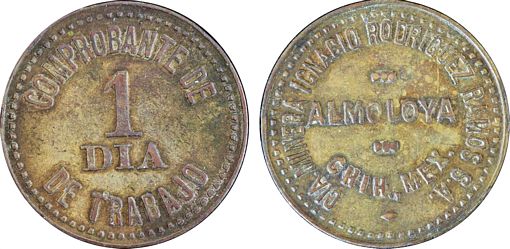
Grove 1729
Obverse: CIA. MINERA IGNACIO RODRIGUEZ RAMOS S.A. / ALMOLOYA / CHIH, MEX
Reverse: COMPROBANTE DE / 1 / DIA / DE TRABAJO
30 mm.
In 1903 it was reported that the Cocheño mine was paying its workers in fichas of 1, 2 and 4 reales to be used in the tienda de raya{footnote}MONEDA ILEGAL. – Se ha tenido noticia de que la Compañía beneficiadora de metales, dueña de la hacienda de Cocheño, en el Distrito de Rayón, Chihuahua, con objeto de obligar á sus trabajadores á que no hagan consumo mas que en la tienda de la hacienda, ha acuñado y puesto en circulación unas fihas de aluminio á las que se ha asignado el valor de uno, dos y cuatro reales, haciendo las rayas con esas fichas. Es de suponer que ese delito, penado por la ley y que encierra además un criminal abuso contra los infelices trabajadores, será castigado con todo el rigor que merece. (El Tiempo, Año XX, Núm. 5872, 8 May 1903){/footnote}.
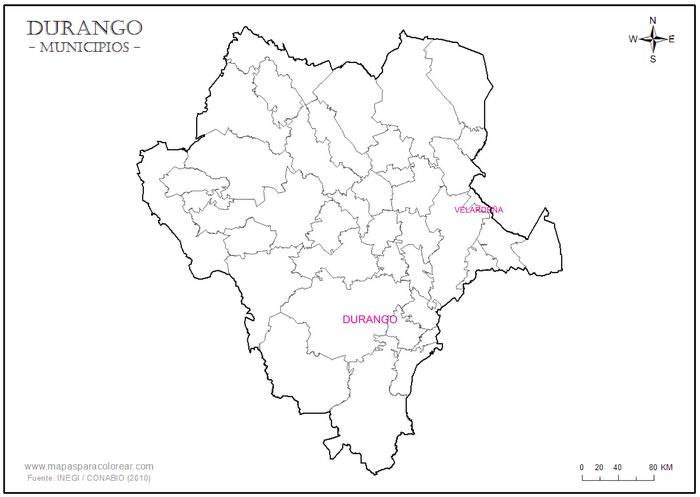
Grove 1738
Obverse: CIA MINERA SAN ANDRES DE LA SIERRA / 1
Reverse: VALE EN EFECTOS EN LA TIENDA DE RAYA / 1
18mm. white metal
Grove 1739
Obverse: CIA MINERA SAN ANDRES DE LA SIERRA / 2
Reverse: VALE EN EFECTOS EN LA TIENDA DE RAYA / 2
24 mm. white metal
In 1890 the company employed 1,282 men with a weekly payroll of between $5,000 and $6,000{footnote}Memoria de la Secretaría de Fomento, [ ]{/footnote}. In October 1899 it was reported that people in San Andrés de la Sierra were complaining that this company made their payroll every six weeks with the object of forcing workers to take out credit with the tienda de raya. A Mexico City newspaper hoped that this terrible injustice would be remedied{footnote}El Popular, Mexico, 13 October 1899{/footnote}.
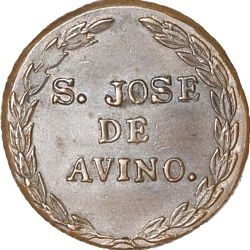
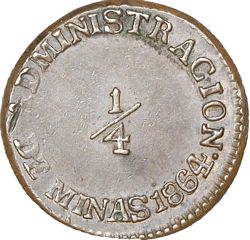
Grove 1740 San José de Avino ¼ 1864 (Briggs & Bustos auction, 11 April 2023, lot 208)
Grove 1740
Obverse: S. JOSE / DE / AVINO
Reverse: ADMINISTRACION / ¼ / DE MINAS 1864.
20 mm. bronze
The 'E' in José was first punched with an 'F' and then the lower serif was hand engraved.


Grove 1741
Obverse: S. JOSE / DE / AVINO. (S reversed)
Reverse: ADMINISTRACION / 2 RS / DE MINAS 1864 (both S reversed)
28 mm. bronze
Grove 1742
Obverse: S. JOSE / DE / AVINO. (S reversed)
Reverse: ADMINISTRACION / 2 RS / DE MINAS 1864 (both S reversed) counterstamped AO
28 mm. bronze
Grove 1743
Obverse: S. JOSE / DE / AVINO.
Reverse: ADMINISTRACION / 1 PESO / DE MINAS 1864
38 mm. bronze
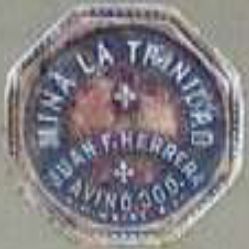

Grove 1750
Observe: MINA LA TRINIDAD / JUAN F. HERRERA / AVINO, DGO.
Reverse: ES BUENO POR / 50
27mm.
made by L. H. Moise, S. F.


Observe: MINA QUIEN SABE / 6 / LA TRINIDAD DURANGO.
Reverse: pick and shovel


Observe: MINA QUIEN SABE / 25 / LA TRINIDAD DURANGO
Reverse: pick and shovel


Observe: MINA QUIEN SABE / 50 / LA TRINIDAD DURANGO.
Reverse: pick and shovel
These were made by L. H. Moise of San Francisco.
This was operated by the Santa Cruz Mining Company of San Antonio, Texas.
Grove 1744
Obverse: MINAS DE / SANTA CRUZ / DURAZNITO,
Reverse: VALE / 5 / EN LA TIENDA / DE RAYA
22 mm. bronze
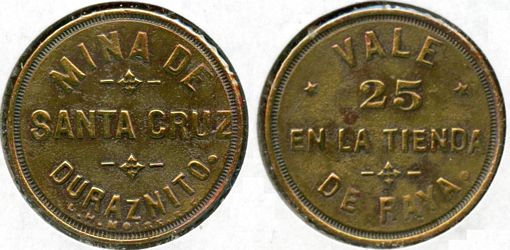
Grove
Obverse: MINAS DE / SANTA CRUZ / DURAZNITO,
Reverse: VALE / 25 / EN LA TIENDA / DE RAYA
Grove 1745
Obverse: MINAS DE / SANTA CRUZ / DURAZNITO,
Reverse: VALE / 100 / EN LA TIENDA / DE RAYA
22mm. bronze
These were produced by L. H. Moise, S. F.


Grove 1992
Obverse: FAVELA HERMANOS / LA UNION / MAPIMI DGO MEXICO
Reverse: 5
25mm. nickel
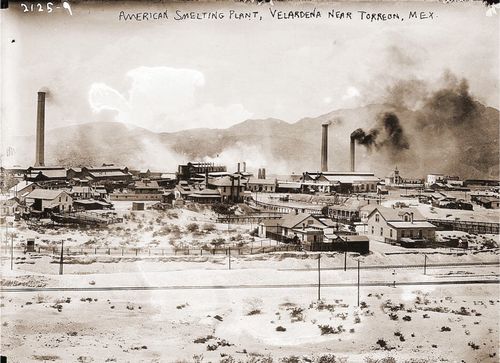
Velardeña is a mining centre situated in Cuencamé, Durango, established by a concession of the Porfirista government on 15 May 1893 to the Velardeña Mining and Smelting Company. In 1905 the company was acquired by a mining syndicate (later known as American Smelting and Refining Co. (ASARCO)) and this, represented by Rafael Prado, was granted a new concession on 17 October 1905.
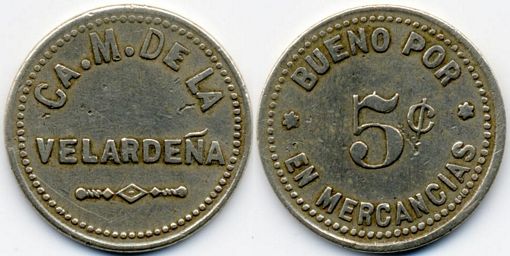
Grove 1997
Obverse: CA. M. DE LA / VELARDEÑA
Reverse: BUENO POR / 5¢ / EN MERCANCIAS
20mm. nickel

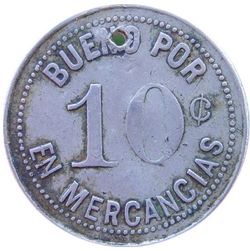
Grove 1998
Obverse: CA. M. DE LA / VELARDEÑA
Reverse: BUENO POR / 10¢ / EN MERCANCIAS
25mm. nickel
Grove 1999
Obverse: CA. M. DE LA / VELARDEÑA, counterstamped M
Reverse: BUENO POR / 10¢ / EN MERCANCIAS
25mm. nickel
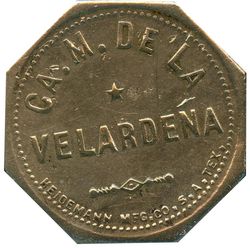
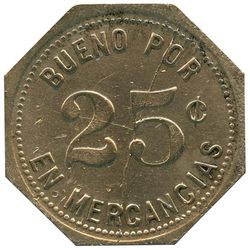
Grove 2000
Obverse: CA. M. DE LA / VELARDEÑA
Reverse: BUENO POR / 25¢ / EN MERCANCIAS
25mm. nickel. octagonal


Obverse: CA. M. DE LA / VELARDEÑA
Reverse: BUENO POR / 25¢ / EN MERCANCIAS
round
These were maid by the Heidemann Manufacturing Company of San Antonio, Texas.